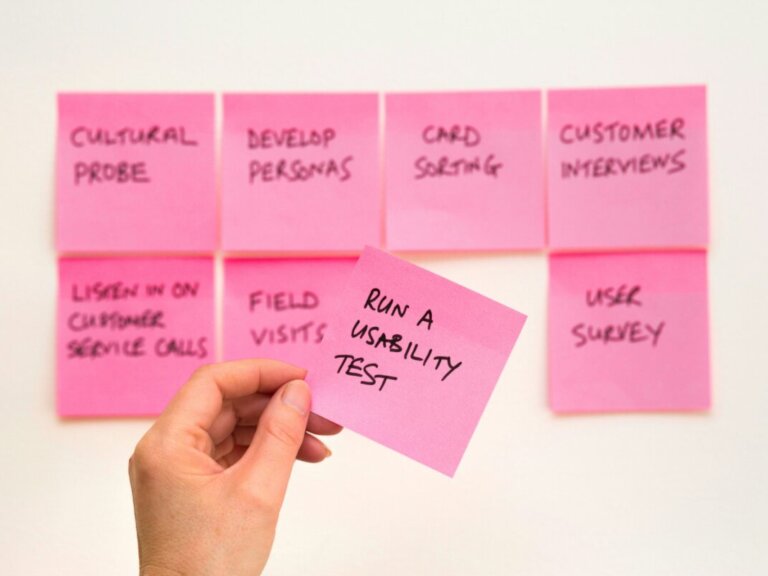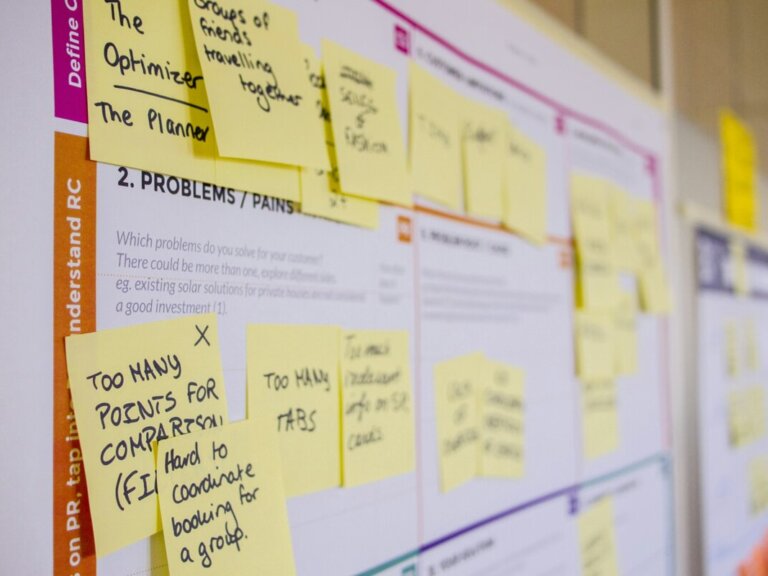
Author: Anna Schötz
· 4 mins read · 1,219 views
Tips for Scrum Master
Scrum is about collaboration in the form of different roles, meetings and tools based on agile principles. There are several events that a Scrum Master need to have an overview of: The Daily Standup, the Retrospective and also the Sprint Planning. We have collected a few tips for this here.
Daily Scrum
What is a Daily Scrum?
Daily Standups (or Daily Scrum) are a central practice for agile work. In this daily meeting, an agile team organizes itself and its work without the involvement of managers or external decision-makers. The participants of the Daily Standup stand together for a maximum of 15 minutes and talk in turn about the results of the previous day, barriers and their plan for the current day. In this way, the team members make their status and major problems transparent and can help each other to remove barriers in order to achieve the jointly set goal.
There are usually 3 questions that need to be answered:
- What I did yesterday?
- What I’ll do today?
- What’s in my way?
Rules for a Daily Scrum
- The standup lasts no more than 15 minutes
- Everyone must be on time
- Everyone answers the three questions
- If possible, all participants stand – as the name standup implies
Advantages of a Daily Scrum
- The Daily Scrum improves communication
- It helps to remove obstacles
- Helps with decision making
Tips for Scrum Master
- Make the purpose of the dailies aware: communication
- Leadership by a good Agile coach
- Have meetings continuously every day for 15 minutes
- Schedule regular meeting times
- Prioritize tasks correctly
- Visualize dependencies
- Evaluate the approach on a regular basis
Scrum Retrospective
What is a Scrum Retrospective?
The Scrum Retrospective is a mandatory event described in the Scrum Guide for the agile project management framework Scrum. The goal of the retrospective is to reflect on the experience (from the last sprint). Based on this, improvement measures are sought that can be directly implemented in the next sprint.
Steps:
- Set the Stage – Create Framework Conditions for a Good Retrospective.
- In this first step, it is important that all participants arrive first and feel comfortable. It is important that there is a good atmosphere and that everyone has said something at the beginning of the Scrum Retrospective. This also increases the likelihood that people will join in the discussion later…
- Gather Data
- The second step of a Scrum retrospective is to collect data from the last sprint. The emphasis is on quantity and the focus is on the quantity of facts; a selection and evaluation takes place later. You analyse your concrete experiences and build on them in the further course of the retrospective.
- Generate Insights
- The third step of a retrospective uses the second step to generate deeper insights about the experience. Really good insights are the key to deciding on implementation in the next step.
- Decide What To Do
- In the fourth step, you consider the concrete implementation from your Scrum Retrospective. This step is very important because if you do not define actions in the Scrum Retrospective, continuous improvement is of no use to you.
- Close The Retrospective
- A retrospective in Scrum is closed properly, this is shown by the fifth step. This is important to show respect (read more about the Scrum value respect) for everyone’s work and time. A short reflection on the format is also helpful. This step can be brief, but should not be skipped.
Tips for the Scrum Retrospective
- Other Surroundings
- The bored, windowless 60s-style office literally nips thoughts and ideas in the bud. Often an external space can be found for little money in a co-working location.
- Working Agreement
- Together with the team, define a set of rules that everyone adheres to. Do you already have a working agreement? Perfect, if not try to establish one!
- Wishes into the Backlog
- Continuous improvement tasks belong in the backlog. Each team should take a small improvement with them into the next sprint. Keep it transparent in the backlog.
- Demanding the Impossible
- Change the context and ask bravely, for example, “what do we need to be able to deliver twice as fast?” Even if such questions are not always solvable, they can provide valuable impulses.
- Focus on the Positive
- Use “Set The Stage” and other impulses to focus the retrospective on positive improvements only. How can these be maintained or even improved? Try it!
- Focus the Sprint
- In the retrospective, you should – as usual – keep a clear focus. You always look at the last sprint and look ahead to the next sprint. No more and no less!
Sprint Planning
What is Sprint Planning?
The kick-off of every sprint is the sprint planning meeting. It serves to put together the Scrum team’s work package for the coming Sprint. And the Scrum Master is the person responsible for holding the meeting.
After a Successful Sprint Planning:
- The Product Owner and the Development Team agree on the Sprint Goal
- Have jointly formed the Sprint Backlog. The Sprint Backlog contains all Product Backlog Items (Output) that have to be implemented in the Sprint in order to achieve the Sprint Goal
In order for the product owner and the development team to achieve the two goals of the planning meeting, some prerequisites must be met.
Steps for Good Sprint Planning
- The product owner or Scrum Master has defined a sprint goal and selected the corresponding product backlog items (PBIs).
- Formulate the selected PBIs in sufficient detail – preferably in cooperation with the development team, e.g. in the context of a product backlog refinement.
- The PBIs you selected, have been placed in an order according to which the development team will work on them.
- The team has a Definition of Done (DoD)
- The capacity of the team for the next sprint was determined, e.g. taking into account the average velocity of the last sprints and any planned leave of individual team members.
Once Sprint Planning has been prepared as described, you and your Scrum team can start the actual process:
- The product owner or the Scrum Master presents the sprint goal and the associated PBIs and answers the team’s questions of understanding. The sprint goal should be documented legibly for all team members on the Sprint Backlog.
- If the PBIs have not yet been estimated, you should do the estimation now. If the estimation has already taken place, your team and the Scrum Master can now refine the estimation after the detailed discussion on implementation.
- The team makes a prediction to the product owner and stakeholders about which PBIs it will deliver at the end of the sprint according to the jointly written DoD. This is how the sprint backlog is formed, which should document which PBIs the development team has committed to and which they will optionally work on additionally.
Tips for Good Sprint Planning
- Set a challenging sprint goal
- Pre-plan the sprint planning
- Priorize the tasks
- Don’t overload the sprint
Looking for Expert IT Solutions?
Subscribe to Our Newsletter for Exclusive Tips and Updates!
Stay ahead of tech challenges with expert insights delivered straight to your inbox. From solving network issues to enhancing cybersecurity and streamlining software integration, our newsletter offers practical advice and the latest IT trends. Sign up today and let us help you make technology work seamlessly for your business!



Share